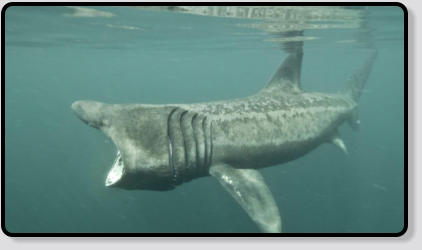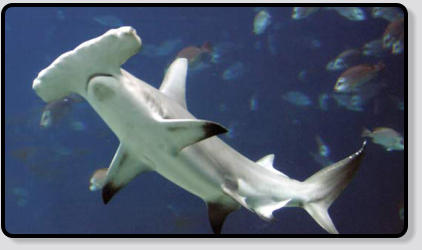Scientific classification
Kingdom:
Phylum:
Chordata
Class:
Chondrichthyes
Order:
Orectolobiformes
Family:
Rhincodontidae
Genus:
Rhincodon
Species:
R. typus
Binomial name (link Wikipedia)





Whale Shark
Requin Baleine
Walhai
Tiburón Ballena
Walvishaai

The whale shark (Rhincodon typus) is a slow-moving filter feeding shark and the largest known extant fish species. The largest confirmed
individual had a length of 12.65 m (41.5 ft) and a weight of about 21.5 t (47,000 lb). Unconfirmed claims of considerably larger individuals, over
14 m (46 ft) long and weighing at least 30 t (66,000 lb), are not uncommon.[citation needed] The whale shark holds many records for sheer size
in the animal kingdom, most notably being by far the largest living nonmammalian vertebrate. It is the sole member of the genus Rhincodon and
the only extant member of the family, Rhincodontidae (called Rhiniodon and Rhinodontidae before 1984), which belongs to the subclass
Elasmobranchii in the class Chondrichthyes. The species originated about 60 million years ago.
Description
The whale shark is found in open waters of the tropical oceans and is rarely found in water below 22 °C (72 °F). Modeling suggests a lifespan of about 70
years, but measurements have proven difficult. They have very large mouths and are filter feeders, which is a feeding mode that occurs in only two other
sharks, the megamouth shark and the basking shark. They feed almost exclusively on plankton and, therefore, are completely harmless to humans.
The species was distinguished in April 1828 after the harpooning of a 4.6 m (15 ft) specimen in Table Bay, South Africa. Andrew Smith, a military doctor
associated with British troops stationed in Cape Town, described it the following year. The name "whale shark" directly refers to the fish's size, being as large
as some species of whales and also that it is a filter feeder like baleen whales.

Animalia
Scientific classification
Kingdom:
Phylum:
Chordata
Class:
Chondrichthyes
Order:
Lamniformes
Family:
Cetorhinidae
Genus:
Cetorhinus
Species:
C. maximus
Binomial name (link Wikipedia)





Basking Shark
Requin Pèlegrin
Riesenhai
Tiburón Peregrino
Reuzenhaai

The basking shark (Cetorhinus maximus) is the second largest living fish, after the whale shark, and one of three plankton-eating sharks along
with the whale shark and megamouth shark. Adults typically reach 6–8 m (20–26 ft) in length. They are usually greyish-brown, with mottled skin.
The caudal fin has a strong lateral keel and a crescent shape.
The basking shark is a cosmopolitan migratory species, found in all the world's temperate oceans. A slow-moving filter feeder, its common name
derives from its habit of feeding at the surface, appearing to be basking in the warmer water there. It has anatomical adaptations for filter feeding,
such as a greatly enlarged mouth and highly developed gill rakers. Its snout is conical and the gill slits extend around the top and bottom of its
head.
Description
The gill rakers, dark and bristle-like, are used to catch plankton as water filters through the mouth and over the gills. The teeth are very small and
numerous, and often number one hundred per row. The teeth have a single conical cusp, are curved backwards, and are the same on both the
upper and lower jaws. This species has the smallest weight-for-weight brain size of any shark, reflecting its relatively passive lifestyle.
Basking sharks are believed to overwinter in deep waters. They may be found in either small schools or alone. Small schools in the Bay of Fundy
and the Hebrides have been seen swimming nose to tail in circles in what may be a form of mating behaviour.
Despite their large size and threatening appearance, basking sharks are not aggressive and are harmless to humans. It has long been a
commercially important fish, as a source of food, shark fin, animal feed, and shark liver oil. Overexploitation has reduced its populations to the
point where some have disappeared and others need protection.
Animalia
Scientific classification
Kingdom:
Phylum:
Chordata
Class:
Chondrichthyes
Order:
Lamniformes
Family:
Lamnidae
Genus:
Isurus
Species:
I. oxyrinchus
Binomial name (link Wikipedia)





Shortfin Mako Shark
Taupe Bleue
Kurzflossen-Mako
Marrajo
Kortvinmakreelhaai

The shortfin mako shark is a fairly large species of shark. An average adult specimen measures around 3.2 m (10 ft) in length and weigh from
60–135 kg (132–298 lb). The species is sexually dimorphic, with females typically larger than males. The largest shortfin mako shark taken on
hook-and-line was 600 kg (1,300 lb), caught off the coast of California on June 3, 2013. Larger specimens are known, with a few large, mature
females exceeding a length of 3.8 m (12 ft) and a weight of 570 kg (1,260 lb). The longest verified length for a Shortfin Mako, caught off of the
coast of France in September 1973, was 4.45 m (14.6 ft). It can attain bursts of speed up to 18.8 metres per second (42 mph). A specimen
caught off the coast of Italy and examined in an Italian fish market in 1881 was reported to weigh an extraordinary 1,000 kg (2,200 lb) at a length
of 4 m (13 ft). Growth rates appear to be somewhat accelerated in the shortfin mako in comparison to other species in the lamnid family.
Description
The shortfin mako shark is cylindrical in shape, with a vertically elongated tail. This species exhibits countershading, with brilliant metallic blue
coloration dorsally and white ventrally. The line of demarcation between blue and white on the body is distinct. The underside of the snout and
the area around the mouth are white. Larger specimens tend to possess darker coloration that extends onto parts of the body that would be white
in smaller individuals. The juvenile mako differs in that it has a clear blackish stain on the tip of the snout. The longfin mako shark very much
resembles the shortfin mako shark, but has larger pectoral fins, dark rather than pale coloration around the mouth and larger eyes. The presence
of only one lateral keel on the tail and the lack of lateral cusps on the teeth distinguish the makos from the closely related porbeagle sharks of the
genus Lamna.
Animalia
Scientific classification
Kingdom:
Phylum:
Chordata
Class:
Chondrichthyes
Order:
Carcharhiniforme
s
Family:
Sphyrnidae
Genus:
Sphyrna
Species:
S. zygaena
Binomial name (link Wikipedia)





Smooth Hammerhead Shark
Requin Marteau Commun
Gemeiner Hammerhai
Tiburón Martillo
Gladde Hamerhaai

The smooth hammerhead (Sphyrna zygaena) is a species of hammerhead shark, and part of the family Sphyrnidae. This species is named
"smooth hammerhead" because of the distinctive shape of the head, which is flattened and laterally extended into a hammer shape (called the
"cephalofoil"), without an indentation in the middle of the front margin (hence "smooth"). Unlike other hammerheads, this species prefers
temperate waters and occurs worldwide at medium latitudes. In the summer, these sharks migrate towards the poles following cool water
masses, sometimes forming schools numbering in the hundreds to thousands.
The second-largest hammerhead shark after the great hammerhead shark, the smooth hammerhead can measure up to 5 m (16 ft) long. It is an
active predator that takes a wide variety of bony fishes and invertebrates, with larger individuals also feeding on sharks and rays. As in the rest of
its family, this shark is viviparous and gives birth to litters of 20–40 pups. A relatively common shark, it is captured, intentionally or otherwise, by
many commercial fisheries throughout its range; its fins are extremely valuable for use in shark fin soup. This shark is potentially dangerous and
has likely been responsible for a few attacks on humans, though it is less likely to encounter swimmers than other large hammerhead species
due to its temperate habitat.
The smooth hammerhead differs from other large hammerheads in the shape of its cephalofoil, which has a curved front margin without an
indentation in the center.
Description
Animalia
Scientific classification
Kingdom:
Phylum:
Chordata
Class:
Chondrichthyes
Order:
Carcharhiniforme
s
Family:
Triakidae
Genus:
Mustelus
Species:
M. mustelus
Binomial name (link Wikipedia)





Smoot Hound Shark
Emissole Lisse
Glatthai
Cazón
Toonhaai

The common smooth-hound (Mustelus mustelus) is a houndshark of the family Triakidae. It is found in the eastern Atlantic Ocean from the British
Isles to South Africa, and in the Mediterranean Sea, Madeira, and the Canary Islands at depths ranging from 5 m to 625 m (although they usually
stay at depths between 5-50m). While they can grow to 200 cm, their usual maximum size is 150 cm. They commonly grow to 100–120 cm with a
birth length around 35 cm. The reproduction of commons smooth-hounds is viviparous.
The common smooth-hound has a grey-brown back and is white on its underneath. It is often confused with the starry smooth-hound which has
white spots on its back. The starry smooth-hound can often have faded spots which leads to misidentification. Another shark it is often confused
with is the tope shark although the common smooth hound has a larger second dorsal fin. Due to the similarities between the common smooth-
hound and other sharks, misidentification occurred for a long time.
The common smooth-hound has two dorsal fins, an anal fin, a pair of pectoral fins, a pair of pelvic fins and a heterocercal tail. All of these fins
help stabilise the shark but in males, the pelvic fins are modified to form claspers.
Like other smooth hounds, the common smooth hound will aggregate in large numbers, like a pack of dogs. This is why they are called hounds.
Description
Animalia
Scientific classification
Kingdom:
Phylum:
Chordata
Class:
Chondrichthyes
Order:
Squatiniformes
Family:
Squatinidae
Genus:
Squatina
Species:
Squalus squatina
Binomial name (link Wikipedia)





Angel Shark
Ange de Mer
Engelhai
Angelote
Engelhaai

Squatina is a genus of shark in the family Squatinidae, which are unusual in having flattened bodies and broad pectoral fins that give them a
strong resemblance to rays. This genus is the only one in its family and order Squatiniformes. They occur worldwide in temperate and tropical
seas. Most species inhabit shallow temperate or tropical seas, but a few species inhabits deeper water, down to 1,300 m (4,300 ft). Angel sharks
are sometimes called monkfish, although this name is also applied to members of the genus Lophius.
While the forward part of the angel shark's body is broad and flattened, the rear part retains a muscular appearance more typical of other sharks.
The eyes and spiracles are on top and the five gill slits are on its back. Both the pectorals and the pelvic fins are large and held horizontally.
There are two dorsal fins, no anal fin and unusually for sharks, the lower lobe of the caudal fin is longer than the upper lobe. Most types grow to a
length of 1.5 m (5 ft), with the Japanese angel shark, known to reach 2 m. Angel sharks possess extensible jaws that can rapidly snap upwards
to capture prey and have long, needle-like teeth. They bury themselves in sand or mud lying in wait for prey, which includes fish, crustaceans and
various types of mollusks.They are ovoviviparous, producing litters of up to 13 pups.
Although this shark is a bottom-dweller and appears harmless, it can inflict painful lacerations if provoked, due to its powerful jaws and sharp
teeth. It may bite if a diver approaches the head or grabs the tail.
Description
Animalia





Harry van Goor 2016
source: Wikipedia, the free encyclopedia


Categories: Sharks